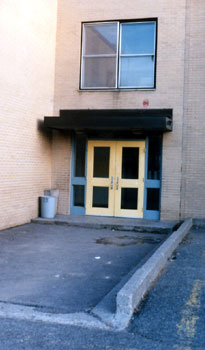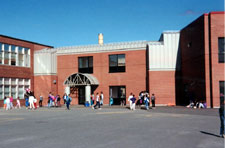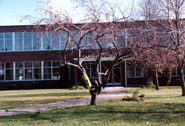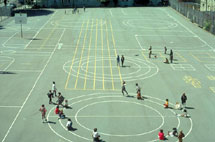|
Overall image of the school
Click to enlarge
 |
This is the stage where you find out what kind of image the school has, what everyone feels about the grounds and what they like and dislike. Surveying everyone in the school community is an ideal opportunity for a hands-on cross-curricular project for the whole school.
Scale, shelter, space, division of space, and places
It is important to discuss the variations in scale, shelter, space, division of space, and places on the site and to determine how they are used, how they affect children's behaviour and whether they meet the needs of the children.
Scale
How does the scale or size of a space influence its use? You can determine how the various spaces in your schoolyard are being used by watching and photographing the children at play and taking notes.
Click to enlarge
 |
Wide open spaces are often commandeered by children, usually boys, kicking balls around. Younger, quieter or smaller children frequently play around the edges of the yard rather than in the middle because they are often intimidated by large open spaces and are afraid of being kicked, hit by a ball, knocked down or yelled at for being in the way.
To make a more equitable schoolyard, preserve or create child-scale spaces that are designed to suit different ages, abilities, needs and preferences.
Shelter
Is there any shelter from Winter winds and Summer sun? Can smaller or quieter children get away from areas where bullying might take place?
Click to enlarge
 |
According to the teachers surveyed, certain kinds of spaces adversely affect children's behaviour. Wide-open, windy spaces and asphalt suntraps can make children feel irritable, uncomfortable and unwell. They are then disinclined to work when they come back to the classroom.
Shelter includes windbreaks, shade trees, structures such as gazebos and arbours, and places where children can take refuge from noise, active or boisterous play and bullying.
Bullying
The majority of schools appear to have a problem with bullying but many are reluctant to admit it. You cannot solve this problem unless you first acknowledge it and then identify the places where it occurs. You will probably find that the spots favoured by bullies are just off the main sight lines from points within the yard and from inside the school building. Bullying is also more likely to happen away from areas busy with children who might "tell on them". You can reduce bullying through improving the sight lines and increasing interest in featureless spaces that currently do not attract many children.
Space
How much space is there and how it is used?
Patterns of activity may have developed in certain locations either by tradition or by some groups claiming territorial rights. This may not result in the most effective use of the space. Large, open spaces may also be used inefficiently because they are devoid of interest.
Division of space
Is the space divided between grades or is the entire space shared by all the children?
The lack of space or poor design, which often causes localized congestion, may have resulted in the division of space by age. Research shows that the segregation by age may increase aggressive play among older children through removing their need to take care of the little kids.
"Many children derive great pleasure from playing with younger ones. The opportunity for children to mix with those of a different age, to learn to take account of their needs, and to pass on games and skills is a positive and valuable part of the informal curriculum."
Play, Playtime and Playgrounds by Wendy Titman, 1992 Do you have space or places?
Click to enlarge

| Photo: |
Robin Moore & Susan Goltsman,
Play for All |
|
Space does not always equal place! |
Many schools have large open spaces for games and physical activities but few offer the kinds of quiet child-scale places that help develop in children a sense of place and a sense of belonging to a place. Children need places to become attached to and places to be in - to sit, read, think, and do things such as make up stories, act out plays, paint, make crafts, play board games, watch bugs, explore the soil and socialize with friends.
How are the grounds used?
You will need to think about identifying the current needs and uses of the grounds by the whole school and the community in all seasons of the year.
Communicating
Get into the habit of keeping people informed about what you are thinking of doing by way of school newsletters, flyers, community newspapers, displays and presentations. It's important to advertise to keep people interested in "buying" into your idea.
Gaining approval for conducting the surveys
You will need to ask the principal and teachers for their support and assistance before starting the people and site surveys.
Write your own history!
Start keeping written and photographic records of your school grounds activities. They may prove invaluable for gaining project approvals and broad community support, fundraising and mounting displays. Also, the records will be very useful for people to refer to in the future.
Avoid setbacks!
Don't let things fall through the cracks! Try to gain approval for everything and get it in writing. Paper trails can be useful, particularly when administrative staff who approved aspects of your project move to another school, change jobs or retire.
[ Back to top ]
|